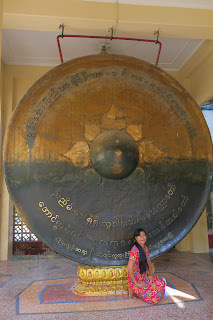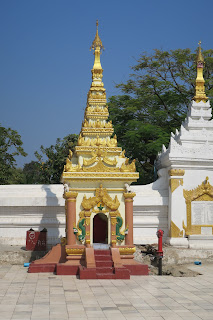The Mahamuni Buddha Temple (also called the Mahamuni Image) is a Buddhist
temple and major pilgrimage site, located southwest of Mandalay, Myanmar
(Burma). The Mahamuni Buddha image (literal meaning: The Great Sage) is
deified in this temple, and originally came from Arakan. It is highly
venerated in Burma and central to many people's lives, as it is seen as an
expression of representing the Buddha's life.
Ancient tradition refers to only five likenesses of the Buddha, made during
his lifetime; two were in India, two in paradise, and the fifth is the
Mahamuni Buddha image in Myanmar. According to the legend, the Buddha visited
the Dhanyawadi city of Arakan in 554 BC. King Sanda Thuriya requested that an
image was cast of him. After casting the Great Image, the Buddha breathed upon
it, and thereafter the image became the exact likeness of the Mahamuni.
|
Entering Mahamuni Buddha Temple.
|
|
Lion protecting the entrance to the temple.
Chinthe is the Burmese word for 'lion'. The leograph of Chinthe is a
highly stylized lion commonly depicted in Burmese iconography and
architecture, especially as a pair of guardians flanking the entrances
of Buddhist pagodas and kyaung (or Buddhist monasteries).
|
|
Stalls on each side of the pedestrian path.
The arcades leading to the main shrine have many kiosks, selling
religious paraphernalia such as incense, candles, rosaries, flowers,
robes, sandals etc., and various restaurants and tea shops.
|
|
Entering the Main Temple/Pagoda.
|
|
Mahamuni image.
The Mahamuni Buddha image is housed in a small gandhakuti chamber,
seated on a throne in a divine posture known as the Bhumisparsa Mudra.
- This posture or mudra symbolises Buddha's vanquishing of Mara.
-
The legs are crossed with feet turned inwards, and the right hand
touches the ground ritualistically, as a witness of his past deeds.
|
|
Male worshippers adding gold leaf to the statue.
Gold leaves are regularly applied to the face of the Mahamuni Buddha by
male devotees.
-
Consequent to the frequent application of gold leaves, the coating of
gold (thickness 15 centimetres (5.9 in)) has given a shapeless contour
to the Mahamuni image.
-
In 1884, when the pagoda was burnt down, 91 kilograms (201 lb) of gold
was recovered from the site, which represents the continued historical
veneration and perpetuation of the cult of Mahamuni.
|
|
Right side of Buddha statue.
It is noted that the right hand, crown and other iconographic
characteristics of royalty are free of gold leaf covering, which gives
an impression that these were later additions to the original image of
the Mahamuni.
|
|
Women worshiping in front of the Buddha statue.
|
|
Nuns worshiping in front of the Buddha statue.
|
|
Approaching the Buddha statue.
To get closer to the Buddha statue we have to go through a metal
detector.
|
|
Several standing golden Buddhas surround the stupa.
These sculptures are known as Mandalay style Buddhas.
|
|
Exterior of Mahamuni Buddha stupa.
The sanctum sanctorum, where the large Mahamuni image is deified, is a
small chamber and has a roof covering made up of seven
pyatthat meaning tiered roofs (derivative of the Sanskrit word
prasada).
|
|
Bronze Statue Museum.
The Bronze Statue Museum within the Mahamuni Buddha Temple, features six
large bronze statues that originate from Angkor Wat in Cambodia.
|
|
Bronze Statues.
Besides a statue of the multi-headed white elephant Airavata, there are
three statues of mythological lions called Chinthe, and two
warriors said to represent Shiva.
-
Visitors to the temple used to come here to rub a particular part of
their bodies against the statues believing that they have healing
qualities, hence the statues were eventually relocated to the centre
of the hall and now stand on an elevated platform behind glass panels,
thus still allowing for devotees to walk around the statues or even
perform a thaksinahwat, while safeguarding the ancient bronzes at the
same time.
|
|
Mythological lion.
Chinthe is the Burmese word for 'lion'. The leograph of Chinthe is a
highly stylized lion commonly depicted in Burmese iconography and
architecture, especially as a pair of guardians flanking the entrances
of Buddhist pagodas and kyaung (or Buddhist monasteries).
|
|
Warrior said to represent Shiva.
Shiva (lit. 'The Auspicious One'), also known as Mahadeva (lit. 'The
Great God'), is one of the principal deities of Hinduism. He is the
Supreme Being in Shaivism, one of the major traditions within Hinduism.
|
|
Shrine of the local nat spirit.
All Buddhist shrines have their local protective nat spirit.
|
|
Lion protecting the entrance to the sanctuary.
Chinthe is the Burmese word for 'lion'. The leograph of Chinthe is a
highly stylized lion commonly depicted in Burmese iconography and
architecture, especially as a pair of guardians flanking the entrances
of Buddhist pagodas and kyaung (or Buddhist monasteries).
|
|
Image of the local nat spirit.
Take note of the stone that is on the ground.
|
|
Believer worshiping the nat spirit.
Take note of the divination stone in front of her.
|
|
Questioning the nat spirit.
The questioner puts the question to the nat spirit. Then she
lifts the stone.
- If the stone feels heavy, the answer is 'no'.
- If the stone feels light, the answer is 'yes'.
-
The questions can be repeated as many times as necessary until the
entire subject is clarified.
|
|
Shrine with the zodiac signs of each day of the week.
The Burmese zodiac employs eight signs in a seven-day week, with each
sign representing its own day, cardinal direction, planet (celestial
body) and animal; it is known as the "Mahabote zodiac".
|
|
Library of Mahamuni Buddha Temple.
|
|
Small shrine next to the bell tower.
|
|
Earth Goddess.
Vasundhara or Dharani is a chthonic goddess from Buddhist mythology of
Theravada in Southeast Asia.
-
In Burmese, she is known as Wathondare or Wathondara (from Pali:
vasundhara) and variously transliterated as Wathundari, Wathundaye,
Vasundari, etc.
-
Images of Phra Mae Thorani are common in shrines and Buddhist temples
of Burma, Cambodia, Thailand and Laos.
-
According to Buddhist myths, Phra Mae Thorani is personified as a
young woman wringing the cool waters of detachment out of her hair to
drown Mara, the demon sent to tempt Gautama Buddha as he meditated
under the Bodhi Tree.
-
See more at
Phra Mae Thorani - Wikipedia.
|
|
Nat spirit offering a conch shell with his hands.
The conch shell is said to represent Buddha's beautiful and resonant
voice, through which he introduced his followers to dharma.
|
See also
Source
Location
















































